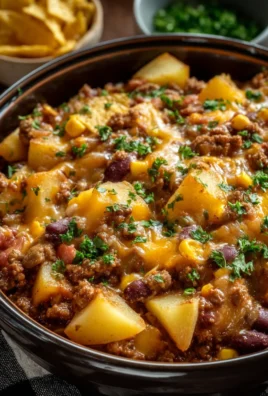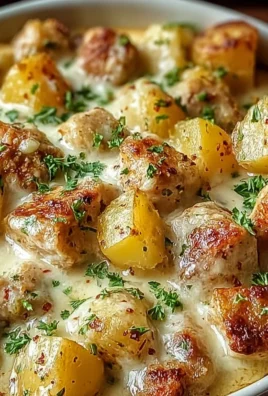
Moroccan Chicken Tagine is more than just a dish; it’s a culinary journey into the heart of Moroccan culture. Known for its rich, aromatic spices and tender, flavorful chicken, this dish encapsulates the essence of Moroccan cuisine. Slow-cooked to perfection in a traditional tagine pot, the dish brings together a symphony of flavors—spices like cumin, turmeric, and ginger, combined with preserved lemons, olives, and a hint of sweetness from dried fruits.
Perfect for communal dining, Moroccan Chicken Tagine is often served with warm, crusty bread or a bed of fluffy couscous, inviting everyone to gather around and share the experience. It’s a dish that reflects the hospitality and vibrant culinary heritage of Morocco, making it a favorite not only in North Africa but around the world.
Historical Background
The origins of Moroccan Chicken Tagine can be traced back to Berber culture, one of the earliest inhabitants of North Africa. The term “tagine” refers both to the dish itself and the conical, clay pot in which it is traditionally cooked. The unique shape of the tagine pot, with its domed lid, allows steam to circulate during cooking, keeping the ingredients moist and flavorful.
As Moroccan cuisine evolved over centuries, influenced by Arab, Andalusian, Mediterranean, and sub-Saharan cultures, the tagine became a staple. The introduction of spices via the ancient spice trade further enriched the dish, with ingredients like saffron, cinnamon, and coriander becoming integral to its flavor profile.
In Moroccan households, the preparation of a tagine is often a communal activity, steeped in tradition. Recipes are passed down through generations, with each family adding its unique touch. Whether prepared for a festive celebration or a simple family meal, Chicken Tagine represents a harmonious blend of history, culture, and culinary artistry.
The Tagine Cooking Vessel
The tagine pot is a quintessential element of this dish, and its design is as functional as it is symbolic. Traditionally made from clay, the tagine consists of two parts:
- A wide, shallow base where the ingredients are layered.
- A conical lid that traps steam and condenses it, allowing the dish to cook slowly in its own juices.
The pot’s construction ensures that the ingredients are tender and infused with the spices’ flavors, creating a moist and aromatic dish. While modern versions of tagines are made from ceramic or come with heat-diffusing bases, traditional clay pots remain a favorite for their ability to impart an earthy depth to the dish.
For those without a traditional tagine pot, alternatives like Dutch ovens or slow cookers can replicate the cooking method, though they may lack the authenticity of clay cooking.
Key Ingredients in Moroccan Chicken Tagine
The ingredients in a Moroccan Chicken Tagine are carefully chosen to create a balance of savory, sweet, and tangy flavors.
1. Chicken
- Bone-in chicken pieces, such as thighs or drumsticks, are preferred for their flavor and tenderness.
- The chicken is often marinated in a mixture of spices and olive oil to enhance its flavor before cooking.
2. Preserved Lemons
- These are a hallmark of Moroccan cuisine, adding a unique tangy and slightly salty flavor.
- Made by fermenting lemons in salt and their juice, preserved lemons are finely chopped or added whole to the tagine.
3. Olives
- Green or purple olives are commonly used, contributing a briny contrast to the dish’s richness.
- Moroccan cured olives, if available, are the best choice for authenticity.
4. Aromatic Spices
- A blend of spices gives the dish its signature flavor. Common spices include:
- Cumin: Earthy and warm, forming the base of many Moroccan dishes.
- Turmeric: Adds a golden hue and a subtle bitterness.
- Ginger: Contributes a zesty, slightly sweet heat.
- Cinnamon: Introduces a sweet-spicy note, often paired with dried fruits.
5. Dried Fruits
- Dried apricots, prunes, or raisins are often included, providing a sweet counterpoint to the savory elements.
6. Vegetables
- Onions form the base of the dish, cooking down to a soft, caramelized consistency.
- Additional vegetables like carrots, potatoes, or zucchini may be added for a heartier version.
7. Fresh Herbs
- Parsley and cilantro are used both during cooking and as a garnish, adding freshness and color.
8. Olive Oil
- A key ingredient in Moroccan cuisine, olive oil enhances the dish’s richness and helps the spices meld together.
Regional Variations
Moroccan Chicken Tagine varies across regions, reflecting the diverse culinary traditions of Morocco.
Northern Morocco
- Influenced by Mediterranean flavors, tagines from this region may include tomatoes, bell peppers, and capers.
Southern Morocco
- Known for the use of sweet elements like dates and almonds, as well as bolder spices like saffron and paprika.
Berber Tagines
- Focus on simplicity, often featuring fewer spices and more emphasis on the natural flavors of the ingredients.
Coastal Regions
- Incorporate seafood elements, substituting chicken with fish or prawns while retaining the preserved lemons and olives.
Health Benefits
Moroccan Chicken Tagine is not only flavorful but also nutritious, thanks to its wholesome ingredients and cooking methods.
1. Rich in Antioxidants
- Spices like turmeric, ginger, and cinnamon are packed with antioxidants, which help combat inflammation and support overall health.
2. Lean Protein
- Chicken provides high-quality protein, essential for muscle growth and repair.
3. Healthy Fats
- Olive oil and olives contribute heart-healthy monounsaturated fats.
4. Nutrient-Dense Vegetables
- Onions, carrots, and other vegetables add vitamins, minerals, and fiber to the dish.
5. Low in Processed Ingredients
- Unlike many modern recipes, traditional tagines rely on fresh, whole ingredients, making them a healthier choice.
Preparation and Cooking Techniques
Moroccan Chicken Tagine is a dish that celebrates the art of slow cooking and the harmonious blending of flavors. Preparing an authentic tagine requires careful attention to layering ingredients, selecting the right tools, and using traditional techniques to achieve tender chicken infused with rich, aromatic spices. This section provides detailed guidance on how to perfect every step of the process, ensuring your dish captures the essence of Moroccan cuisine.
1. Essential Equipment
While a traditional clay tagine pot is ideal for preparing this dish, modern alternatives can also yield excellent results.
The Tagine Pot
- A clay tagine is designed for low and slow cooking. Its conical lid traps steam, allowing the dish to cook evenly in its own juices.
- Always use a heat diffuser under a clay tagine on stovetops to prevent cracking.
Alternative Cookware
- Dutch Oven: Its heavy lid and even heat distribution mimic the tagine’s effects.
- Slow Cooker: Ideal for busy cooks, though the final texture may be slightly different.
- Instant Pot/Pressure Cooker: Speeds up cooking while maintaining moisture. Adjust spice levels to account for shorter cooking times.
Additional Tools
- Sharp knife for slicing vegetables and cutting chicken.
- Wooden spoon for gentle stirring.
- Grater or zester for preparing preserved lemons.
2. Ingredient Preparation
Preparing the ingredients is a crucial step to ensuring even cooking and balanced flavors.
Chicken
- Use bone-in, skin-on chicken thighs or drumsticks for maximum flavor.
- Pat the chicken dry with paper towels to encourage browning.
Marinade
- A spice blend of cumin, turmeric, ginger, and paprika is mixed with olive oil to coat the chicken.
- Let the chicken marinate for at least 1 hour, or overnight in the refrigerator, for deeper flavor penetration.
Preserved Lemons and Olives
- Rinse preserved lemons to remove excess salt. Slice them into thin strips or dice them finely.
- Choose high-quality green or purple olives. Pitted olives save time, but whole olives offer better texture.
Vegetables
- Onions should be thinly sliced and caramelized at the base of the tagine for a sweet, rich foundation.
- Carrots, zucchini, potatoes, and bell peppers can be added based on preference. Cut them into even-sized pieces to ensure uniform cooking.
Spice Blend (Ras el Hanout)
- Use a pre-made blend or create your own by combining cumin, turmeric, coriander, cinnamon, ginger, and black pepper.
- Toast the spices briefly in a dry pan to enhance their aroma.
3. Layering Ingredients in the Tagine
The order of layering ingredients in the tagine pot affects the cooking process and flavor distribution.
Base Layer
- Start with a bed of caramelized onions and garlic. This layer prevents the chicken from sticking and forms the base of the sauce.
Chicken Placement
- Arrange the chicken pieces on top of the onions, ensuring they are evenly spaced for even cooking.
Vegetables and Garnishes
- Add the vegetables around and on top of the chicken. Place preserved lemon slices and olives strategically to ensure their flavors permeate the dish.
Spice and Liquid
- Sprinkle the spice blend evenly over the chicken and vegetables.
- Pour chicken broth, water, or a mix of both into the tagine, ensuring the liquid level is low enough to avoid submerging the ingredients.
4. Cooking Process
Traditional Tagine Cooking
- Place the tagine pot over low to medium-low heat with a heat diffuser to protect the clay.
- Cover with the conical lid and allow the dish to simmer gently for 1.5 to 2 hours. Avoid opening the lid too often, as this disrupts the cooking process.
Dutch Oven or Slow Cooker
- For Dutch ovens, cook on the stovetop over low heat or bake in a preheated 325°F (160°C) oven for 1.5 to 2 hours.
- For slow cookers, set on low for 6–8 hours or high for 3–4 hours.
Adjusting Seasoning
- Taste the dish halfway through cooking. Adjust salt, pepper, or spices as needed.
- Add additional preserved lemons or olives for more tangy or briny flavors.
5. Enhancing Flavor with Techniques
Searing the Chicken
- For a deeper flavor, sear the marinated chicken in olive oil before layering it in the tagine. This step caramelizes the spices and locks in juices.
Deglazing the Pot
- After searing the chicken or caramelizing onions, deglaze the pot with a splash of water, chicken broth, or white wine to incorporate the browned bits into the sauce.
Infusing with Herbs
- Add fresh cilantro and parsley stems during cooking for a herbaceous undertone. Remove the stems before serving and garnish with chopped leaves.
Balancing Sweetness and Tanginess
- For a sweeter dish, add dried fruits like apricots, prunes, or raisins during the final 30 minutes of cooking.
- Increase tanginess with a squeeze of fresh lemon juice just before serving.
6. Serving Moroccan Chicken Tagine
Traditional Accompaniments
- Couscous: Fluffy, steamed couscous is the classic side dish, perfect for soaking up the flavorful sauce.
- Moroccan Bread (Khobz): This round, crusty bread is ideal for scooping up the chicken and sauce.
Modern Pairings
- Serve with quinoa or rice for a gluten-free option.
- Roasted or grilled vegetables make a light, complementary side.
Presentation Tips
- Serve the tagine directly from the pot for an authentic and visually appealing presentation.
- Garnish with chopped parsley, cilantro, or toasted almonds for added texture and color.
Beverage Pairings
- Mint tea is a traditional Moroccan drink that pairs well with the rich flavors of the tagine.
- For an alcoholic option, a dry white wine or light red wine complements the dish’s spices.
7. Common Mistakes to Avoid
Overcooking the Chicken
- Bone-in chicken is less likely to dry out, but monitoring the cooking time ensures it remains tender and juicy.
Using Too Much Liquid
- The tagine’s design allows ingredients to cook in their own juices, so only a small amount of liquid is needed.
Skipping the Marinade
- The spice marinade is essential for infusing flavor into the chicken. Skipping this step may result in a bland dish.
Rushing the Cooking Process
- Tagines are meant to be cooked slowly. Rushing the process can lead to unevenly cooked ingredients and underdeveloped flavors.




Leave a Comment